Heritage

Saint Columba's Church is...
- listed as a Protected Structure.
- listed on Ireland's National Inventory of Architectural Heritage.
- the centre of a historic site dating back at least 1,500 years. Read a brief history of Saint Columba's Church.
- open to visitors by appointment. Book a tour.
Protected Structure
Saint Columba's Church is listed as a Protected Structure (PDF). A protected structure is a building, feature or structure of special interest that is protected for architectural, social, archaeological, technical, historical, cultural, artistic and scientific reasons. Read more about Protected Structures.
National Inventory of Architectural Heritage
Saint Columba's Church is listed on the National Inventory of Architectural Heritage in the Architectural, Artistic, Archaeological, and Social Special Categories. Read more about the National Inventory of Architectural Heritage.
A Brief History of Saint Columba's Church
- Introduction
- Saint Columba
- The Book of Kells
- The Holy Well & The Foundation of Swords Monastery
- The Celtic Monastery
- The Medieval Monastery & Brian Boru
- The Cathach: The Book That Caused A Battle & The Exile Of A Saint
- Dissolution & Ruin
- The Church
- The Monuments & The Churchyard
- The Round Tower
- The Square Tower
Introduction
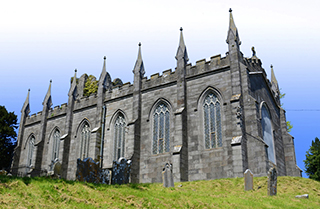 · The church today
· The church today
Saint Columba's Church is a beautiful and massive Georgian cut-stone building on a hill that overlooks the bustling town of Swords.
The way up to the church passes between venerable yew trees, and is flanked by two towers.
The present church at Swords dates back over two hundred years, but the site has a much more ancient history. Swords church has its origins in the abbey church of a monastery which was founded by Saint Columba fifteen hundred years ago.
Saint Columba
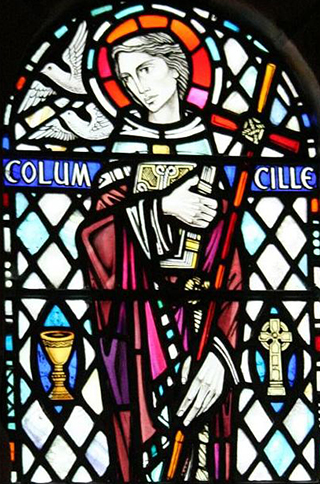 · Saint Columba's window at Iona Monastery
· Saint Columba's window at Iona Monastery
Saint Columba, also known as Saint Columcille, was born in the year 521 AD in Donegal, to a royal family. He was the great-great-grandson of Niall of the Nine Hostages, a legendary Irish High King, who is the ancestor of the modern-day O'Neill clan.
From an early age, Saint Columba was known for his devotion to his faith, and because of it, he was given the name 'Columba' or 'Columcille' which means 'Dove of the Church.'
As he grew up, he became a student at a monastery, and then in time a monk, and then a priest.
Following his ordination, Saint Columba travelled around Ireland, which at the time was a pagan country, to preach the Christian faith, and to baptise converts as he went.
Saint Columba founded several monasteries in Ireland, including those at Derry, Durrow, Kells, and Swords.
The Book of Columba a.k.a. The Book of Kells
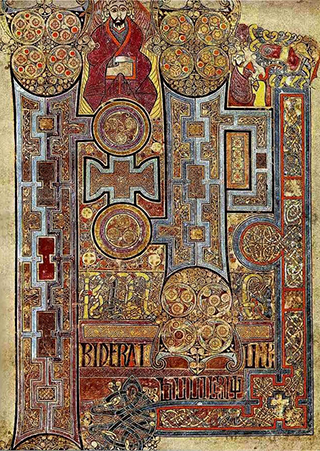 · The Book of Kells a.k.a. The Book of Columba
· The Book of Kells a.k.a. The Book of Columba
The monks at the monasteries that Saint Columba founded included calligraphers at the pinnacle of their art. Every monastery had its scriptorium, where monkish scribes laboured to copy the scriptures in order to spread the word of God.
They wrote on vellum, a type of parchment made from treated calfskin, with pens made of goose feathers, containing inks compounded of crushed minerals and extracts of oak gall. Semi-precious stones such as lapis lazuli from as far afield as Afghanistan were powdered to make different colours. For light, they relied on daylight, or used beeswax candles from the abbey's hives, or oil lamps using oil rendered from animals and wicks made of reeds from the river. The manuscripts the monks produced as known as illuminated manuscripts because they were illuminated or lit up by gilded decorations, made by applying either gold leaf, which was gold hammered into incredibly thin sheets, or gold burnish, which was gold that had been powered and mixed with stag's glue.
The monks made the books with such devotion, and beautified and embellished them to such a degree of perfection, that ultimately the books became sacred objects themselves.
In time, the monks of the Columban monasteries were to produce many famous illuminated manuscripts, including The Book of Durrow, and even the most renowned illuminated manuscript in the world, The Book of Kells, also known as The Book of Columba.
This richly decorated holy book is considered to be a masterpiece of art and the foremost treasure of Ireland. One page from it is shown here, and the whole manuscript can be viewed at Trinity College Dublin or online.
The Holy Well & The Foundation Of Swords Monastery
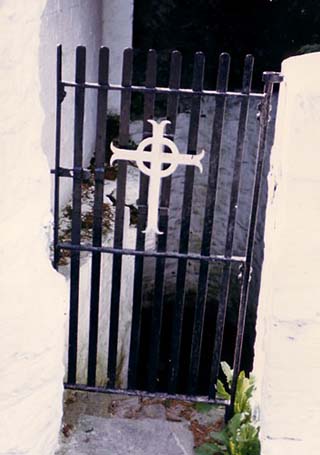 · The holy well on Church Road
· The holy well on Church Road
At Swords, circa 550 AD, Saint Columba gave one of his prayer books to one of his followers, Saint Finian the Leper, and made him the first abbot of Swords monastery.
The abbey was built on the site chosen by Saint Columba. He picked this place because it was on a steep elevation, making it safer from attack, because it was beside a river, which was the main way of getting around in those days, and because it had a supply of good spring water from a well.
Saint Columba blessed the well and called it Sord or Surd, meaning 'clear' or 'pure.' From this well derives the name of the monastery of Swords, which in Irish is Sord Cholmcille. In turn, the monastery gave its name to the town of Swords.
The well is still to be seen at the bottom of the hill on which the church stands. It is protected by an iron gate.
Life in The Celtic Monastery
 · An artist's impression of the early monastery
· An artist's impression of the early monastery
As in this artist's impression, the original monastery at Swords was built of small thatched houses made of wattle and daub, which was woven wood plastered with mud, with a larger one serving as the monks' chapel.
The monks made a living by farming the land around the monastery, and educating young people sent to them, as Columba himself had been educated in a monastery school. But they based their lives on Saint Columba's Rule, a set of guidelines that encouraged the monks to live simple, prayerful, hardworking lives.
From these small beginnings, monasteries like the one at Swords laid the foundations for the spread of Christianity both in Ireland and abroad. They became important community centres in an Ireland that had no towns or cities during the early Christian era.
As time went on and the monks' community at Swords became better established, they would have built in stone.
Local people would have chosen to live near the monastery for access to the church and for the safety found in numbers, forming a village that over time began to grow into a town.
The monastery's round tower, which was constructed about two centuries after the community began, offered a measure of protection from marauders, in the form of lawless local men or of the foreign invaders known as the Vikings. Monasteries were usually built on land donated by the local chieftain and for preference inside an existing ring fort or on a hill top for defence. Having a site that was relatively easy to defend was no small consideration. It was a matter of life and death, and in the light of what happened to Glassmore Abbey, the long survival of the abbey at Swords looks almost miraculous.
Glassmore Abbey was another early Celtic monastery, located about a mile away from Swords along the river. It had been founded by Saint Cronan a century after Saint Columba founded Swords, and it flourished for three hundred years. One night, a raiding party of Vikings from Malahide arrived to plunder it. Before dawn, they had utterly destroyed the monastery and slaughtered every single monk.
The Cathach: The Book That Caused A Battle & Exiled A Saint
 · A page from the Cathach
· A page from the Cathach
Later in his life, Saint Columba argued with a fellow church leader about the ownership of another holy book. The story goes that Saint Columba borrowed a Psalter, or copy of the Psalms, from Saint Finnian, and copied it by night in secret by, it's said, a miraculous light that flowed from his fingertips while he worked.
This book, called The Cathach or The Psalter of Saint Columba, still exists and is held by the Royal Irish Academy. The main text is written in Latin, as all holy books of the period were, but it has notes above the main text in Old Irish, and these make it the earliest known writing in the Irish language.
The jewel-encrusted shrine made to contain the manuscript is held by the National Museum of Ireland.
Saint Columba and Saint Finnian's disagreement over this first-ever case of copyright infringement escalated rapidly.
Saint Finnian took Saint Columba to trial at the court of the High King at Tara.
The High King's judgement, in Saint Finnian's favour, was 'To every cow belongs her calf, therefore to every book belongs its copy.'
Saint Columba, a prince himself by birth, did not accept the King's judgement, and this, together with other grievances, led to Saint Columba encouraging his powerful O'Neill relatives to rise up against the King.
In the resulting Battle of Cul Dreimhne in 561, over three thousand men died.
According to some reports, Saint Columba exiled himself from Ireland in sorrow and penance for what he had done, and went with some followers across the sea to Scotland, where he hoped to win as many converts for God as he had caused men to lose their lives.
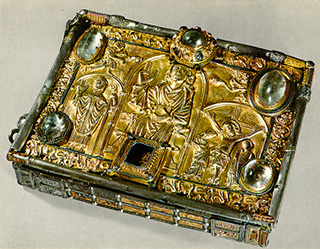 · The Cathach's book shrine
· The Cathach's book shrine
Some other versions of the story say that Saint Columba and his followers simply went to Scotland to preach the Gospel. Whatever the truth of his motivations, Saint Columba and his followers did settle on the Scottish island of Iona. There Saint Columba founded a monastery which still thrives today, and he and his followers set about converting the pagan Picts to Christianity.
Saint Columba spent the rest of his life on missionary work in his adopted homeland. When he grew too frail to travel, he devoted himself to working as a scribe on sacred manuscripts.
One day, Saint Columba was at work on the tenth verse of Psalm 34, and had just completed the words, "They that seek the Lord shall lack no good thing," when he stopped and could do no more. The following day, his fellow monks found him lying before the altar in the church at Iona, and after blessing them, he died.
The words "They that seek the Lord shall lack no good thing" are traced around the chancel arch of Saint Columba's church.
The Medieval Monastery & Brian Boru
 · Sculpture of Brian Boru from Dublin Castle
· Sculpture of Brian Boru from Dublin Castle
The community based around Saint Columba's abbey church grew over the years, and not just in numbers.
As the monks continued their daily devotions of prayer and worship, and their work of farming, caring for the sick, taking in visitors and pilgrims, and studying, copying and preaching the scriptures, the community's reputation as a place of sanctity and learning prospered. Nobles donated land and funds to endow and enrich Swords abbey to the glory of God, and many sent their sons to the abbey school to be educated. As the monastery trained priests and sent them out to minister to other churches and communities, its power and influence increased too.
Such was the fame of Saint Columba's church that Brian Boru the High King of Ireland, and his son Murrough, were waked here after their deaths in the Battle of Clontarf in 1014, before their remains were transported to Armagh cathedral for burial.
 · Artist's impression of the wake of Brian Boru at Swords
· Artist's impression of the wake of Brian Boru at Swords
Brian Boru's life was pivotal in Irish history. He is the ancestor of the modern O'Brien clan. He was the first and greatest of the Irish High Kings, uniting the Irish kingdoms against their common enemy, the Vikings.
At the Battle of Clontarf, on Good Friday 1014, his badly outnumbered army faced a Viking force and defeated them, breaking Viking power in Ireland for good.
He was murdered while at prayer by Vikings fleeing the battlefield, dying at the moment of his greatest triumph.
Dissolution & Ruin
 · The site in the late 1700s
· The site in the late 1700s
Swords had bishops until 1138 AD but it was a regular parish by the time of the Norman invasion. In 1191 AD, it was made a prebendary of Saint Patrick's Cathedral in Dublin.
After the Dissolution of the Monasteries by Henry VIII, in the 16th Century, the monks were forced to abandon their ancient way of life at Swords monastery. The abbey church was left to decay.
The valuable roofing of the abbey church was stripped away. With the roof gone, the building quickly began to deteriorate. Eventually, the stones of the walls were used as a quarry for local buildings.
By 1791, unfortunately, the old abbey church had fallen into ruin. This drawing shows how bad things had become. But better times lay ahead, as the parishioners were planning to rebuild the church.
The Church
 · The church when newly rebuilt
· The church when newly rebuilt
Beginning in 1811, rebuilding of the present church began on the foundations of the old abbey church. Since then it has been the spiritual home of the Church of Ireland parishioners and a venue for all the community.
The church was designed by Francis Johnston, a Georgian architect who is famous for designing the General Post Office on O'Connell Street, and for designing the Chapel Royal in Dublin Castle. Nearer to home, he designed the Old Boro school on the main street of Swords, which is now a public house. The builder was John Hore of Feltrim and a Mister Picknot worked on the interior.
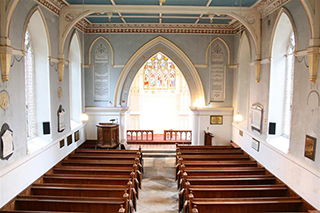 · Interior view towards the chancel
· Interior view towards the chancel
The work cost a total of 2,500 pounds, which in modern money is estimated at about €8 million.
Saint Columba's church is very large, having enough room to seat three hundred people. It is constructed of limestone ashlar, or finely cut and worked stone, and has an ornamental parapet decorated with battlements and pinnacles.
Inside, the church has ornate plasterwork ceilings, and a moulded plaster reredos behind the marble communion table. The Ten Commandments are painted on the walls either side of the chancel arch. In the 1960s, a local lady, Mrs Peck of Rathbeale House, arranged for the walls to be painted with roundels and garlands.
The church contains stained-glass windows, carved timber panelling and furniture, and stone and brass monuments. Each pew has its own individual brass umbrella stand, and its own door. The doors were originally used to ward off draughts but nowadays are mostly used for corralling children.
The East window, which shows Old Testament prophets below, New Testament evangelists above, and the Holy Spirit at the top, was designed by Joshua Bradley in about 1817, making it one of the oldest in Ireland. The Donnelly window in the South wall is nearly as old and features scenes from the life of Jesus, and some inscriptions in Irish.
The church even contains some modern conveniences - relatively speaking - such as the pipe organ in the choir balcony, which retains its hand bellows and candlesticks, and the cast-iron fireplace in the vestry.
 · Interior view towards the gallery
· Interior view towards the gallery
As the present church stands on the same foundations as the original church, the stone flags that line the aisle up to the sanctuary are the original floor of the old abbey church. Under the pews is beaten earth, which contains many burials.
The church is unusual in that it was all built at the same time. Most churches are built in phases over a long period, which often results in their design incorporating many different types of architecture, but Saint Columba's Church is a perfect and complete example of a Georgian church in the Gothic style.
The Monuments & The Churchyard
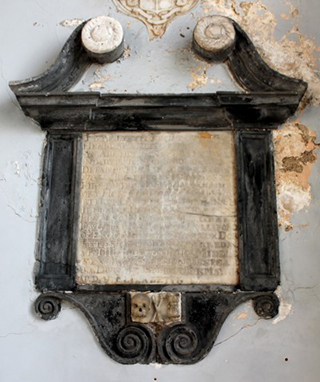 · Monument from 1704 with memento mori
· Monument from 1704 with memento mori
Many of the monuments in the church were preserved from the ancient building. If you look closely, you can see memorial stones dated 1587, 1694, and 1704, including one on the wall that is carved with a skull and crossbones. This 'memento mori' is a reminder of the inevitability of death and of how precious life is.
It's probable that the people of Swords didn't really need much reminding of this fact. For one thing, a memorial of dark stone in the floor of the aisle bears an inscription in Latin commemorating a whole family wiped out in one day by plague.
It's safe to say that after fifteen centuries, Saint Columba's tranquil churchyard has seen many more interments than it would appear at first glance.
The oldest legible gravestone in the churchyard dates back to 1517. Many of the graves in the churchyard are so old that the inscriptions on their gravestones have been worn down or worn away by time, or the gravestones have disappeared completely. Of those that remain, some are monuments not just to the deceased but to pivotal events in Irish history.
In 1590, a colony of Huguenots, French Protestants who had fled their home country due to religious persecution, moved to Swords. Some of the gravestones in Columba's churchyard bear traditional Huguenot names, such as 'Quatermass.' Many notable Irish people are of Huguenot ancestry, including Wolfe Tone, leader of the United Irishmen, and former Taoiseach Sean Lemass.
 · The sexton's lodge built 1870
· The sexton's lodge built 1870
A fine stone tomb near the East end of the church marks the resting place of noted revolutionary J. W. Sweetman.
Sweetman was the son of a rich Roman Catholic brewing and land-owning family, and a leading member of the United Irishmen. He was a rebel and deeply involved in the struggle for Irish freedom. He helped to fund the movement and provided safe houses, as well as organising a sort of underground railroad to smuggle rebels under threat of capture and execution safely out of the country.
Sweetman was a close friend of Wolfe Tone, who when he heard a rumour that Sweetman had been killed wrote this about him: "A better and a braver heart, blood never warmed; If he be gone my loss is unspeakable, but his country will have a much severer one."
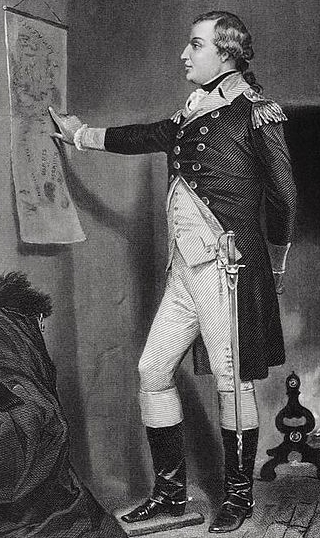 · Richard Montgomery 1738 - 1775
· Richard Montgomery 1738 - 1775
Following the failure of the 1798 Rebellion, Sweetman spent decades in foreign jails and in exile, returning to Ireland after he won a competition to design Dublin's Pro-Cathedral. He died in 1826 and is buried near the East end of the church. Many of his descendants followed in his footsteps and were active in Irish politics; several were TDs (members of the Irish parliament) and one of them co-founded the Irish political party Sinn Fein.
Richard Montgomery is another famous rebel connected with Saint Columba's. He was born in Swords in 1738 and baptised in the church. Eventually he would emigrate to North America, take a part in the struggle for American independence, and ultimately become a leading light in the American Revolutionary War. He died in 1775 leading an attack on Quebec.
The churchyard contains the Sexton's Lodge, which is considered a comparative newcomer to the site, having been built in 1870. It was designed in the Tudor Revival style by James Bell, who also designed the gateposts, and built by William Connolly at a cost of 140 pounds.
The Round Tower
 · The round tower
· The round tower
Beside Saint Columba's Church stand two towers. One is a round tower. Irish round towers were built in the period of the Viking invasions, around 800 to 1000 AD, making the Swords round tower not only the oldest building on this site that is still standing, but one of the oldest buildings in Ireland. It is 26 metres high, but, going by other round towers that have been excavated, its foundations may only go a few metres into the ground.
Round towers are a design of building that is only found in Ireland, although there are a handful of replicas in Scotland and on the Isle of Man, and another replica at The Island of Ireland Peace Park in Belgium, a memorial to the Irish who fell in World War I.
Round towers have lasted as long as they have, because, as the name suggests, they have a round body that is very aerodynamic and helps them withstand strong winds. They were built near monasteries, as bell towers and as watch towers and a place of refuge for the safety of clergy, shrines and treasures. They were really ecclesiastical keeps and were succeeded by the square belfry towers of the religious orders of the 1200 AD and 1300 AD period, one of which may be seen alongside the round tower at Swords.
During the Viking Age, Ireland had no cities, and in fact, very few settlements of any size at all. So a monastery represented a significant concentration of goods and wealth, protected only by holy men who were of a different religion to the Vikings. Originally the round tower would have had a single door high above ground level and only accessible by a ladder, which the monks could pull up after them. Inside, the tower would have had a wooden staircase, but this has long since decayed.
The abbey community would have had a monk acting as a look out in this tower at all times. If this sentinel saw trouble coming, he would raise the alarm, and the monks would take the abbey's valuables, and flee into the oak forests surrounding Swords. The monks who couldn't get away in time would barricade themselves in the round tower and wait out the attacking Vikings.
Eventually the Vikings figured out that it was possible to build stacks of wood around the base of a round tower, set light to them, and make the unfortunate monks have to choose between coming out, or staying inside to suffocate or burn to death.
They were dangerous days. The monastery at Swords was attacked and burnt ten times in its early history.
As time passed, many Vikings began to settle in Ireland, founding cities like Dublin and Waterford, and villages like Howth and nearby Malahide. Round towers like the one at Swords ultimately passed out of use as watch towers, although they remained in use as landmarks and as bell towers.
In the 1700s, a skeleton was found in a shallow grave in the bottom of the round tower. No one knows why someone was secretly buried there.
In the 1800s, around the time that the church was rebuilt, the Rector of the time added the stone cross to the top of the tower.
The Square Tower
 · The square tower
· The square tower
The square tower, also called the Norman tower, was built in the 1300s. It is the only remaining part of the medieval abbey building that is still standing, and its extremely fine masonry shows how majestic the abbey in the middle ages must once have been.
The square tower has defensive features. Apart from the tall and thick stone walls, there are battlements on the roofline, which allowed defenders to shelter behind the tall merlons while they aimed weapons at attackers from the crenellation spaces in between. The small narrow windows allowed in light and air while preventing attackers from getting inside.
However, the shape of the battlement's merlons - rounded rather than rectangular - and the few larger windows the tower has, may show that by the time the square tower was built, that times had changed to more peaceful ones, and so defensive capabilities weren't the first thing on the builders' minds. Or it may simply reflect changes in architectural style, or even renovations.
A clock was added to the structure in the 1700s. At the time, a clock in a prominent building like this one was a real benefit to the local community, who wouldn't have had any other way to tell time, apart from observing the angle of the sun.
The tower has two doors. One leads down into the basement level, and the other opens into a spiral staircase that allows access to all the other floors of the tower. If you look at the doors to the square tower, you can see from the way they are situated that both of them were originally designed to be inside the building rather than open to the weather.
 · The doorways to the square tower
· The doorways to the square tower
If you look above the doorways, you can see the triangular scars in the stonework where the original abbey church walls used to connect to the tower.
Originally, the square tower was covered in a coat of plaster which was painted yellow, and which must have made the tower stand out like a beacon on the hill.
The square tower was used as a belfy when it was first built, and still is to this day, although a 'new' bell was added in the 1700s.
From the top of the square tower, on a fine day, you can see four counties.
Tours
To arrange a tour, call Andrea on +3531 845 3984 or send an email to reachandrea@gmail.com. Tours are free. A donation to the Restoration fund would be much appreciated.



